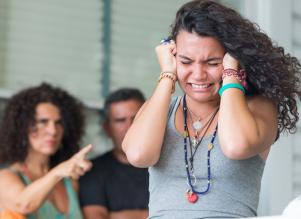10/3/2018
Stress is Showing Up in Our Schools (and Our Teens Don't Know How to Handle It)
Stress is something that every individual experiences at one time or another, but the amount of stress that students are facing—even those in elementary school—has researchers concerned for the state of our youth.
According to a joint study by NPR, The Robert Wood Johnson Foundation, and Harvard School of Public Health, many children and adolescents are under stress when it comes to their education. In total, 31 percent of parents reported that their children had experienced a lot of stress across age groups, including:
-
Almost 40 percent of parents with adolescents in grades nine to 12;
-
36 percent of middle-school parents with students in grades six to eight; and
-
22 percent of parents with children in elementary grades.
This means that even at the youngest level, more than 1 in 5 children have experienced school-related stress. The numbers continue to rise from there, with older students experiencing higher levels of stress as the grades advance.
The study asked parents to review six key sources of stress in the school environment, and to identify whether that item caused their students a lot of stress, a little stress, or no stress. These areas included:
-
Pressure from the child’s school to excel academically
-
The quantity of homework the child had to complete
-
Bullying at school
-
Difficult relationships with other students
-
Violence or safety issues at the child’s school or surrounding neighborhood
-
Difficult relationships with particular teachers
Where does the stress come from? The highest reported cause was homework, with over 16 percent of parents reporting that their children experienced a great deal of stress due to the amount of homework they were given. This number was even higher at the high-school level, with 24 percent of parents identifying quantity of homework as a stressor.
Although elementary school may seem too young for a child to feel stress, Dr. Denise Clark Pope from Stanford University School of Education asserted that it is not. "Stress can begin in elementary school with overscheduling, tests, even tutoring for kids," she noted. "We're seeing more anxiety in elementary students."
Impact of stress on students
While a certain degree of stress can be helpful for motivation and teaching valuable academic and life skills—including time management, responsibility, and critical thinking skills—too much of it can impact a student’s life in detrimental ways.
Mary Alvord, clinical psychologist and public education coordinator for the American Psychological Association (APA), stated that chronic stress can lead to a sense of panic and paralysis where the child feels stuck. Other research has also shown that stress impacts academics and healthy behaviors such as eating, sleeping, and exercising.
So, what are teens doing about stress? For many, the answer is nothing. According to an APA study, teens may not fully grasp how stress impacts their lives and how to handle it. Over half of the teens involved in the study (54 percent) stated that their stress level had only a slight or no impact on their physical health or body, compared to 39 percent of adults, while 52 percent of teens believed stress had no impact or only a slight impact on their overall mental health, compared to 43 percent of adults. In fact, 42 percent of teens said they either weren't doing enough or didn't know if they were doing enough to manage their stress. This is where educators and parents can help.
Guiding students to stress relief
Create a mindful classroom
Yoga and mindfulness meditation have proven psychological and physiological benefits for children, such as improved focus in the classroom and less stress. Integrate simple chair yoga poses, encourage students to record something they are happy about each day in a journal, or guide learners through a short mindfulness meditation by instructing them to close their eyes and focus on the sounds, smells, and feel of their environment.
Teach and encourage “fun”
Despite being critical for social-emotional well-being and development, play is on the decline. Teachers and parents can help by being supportive of free play and emphasizing the importance of occasionally taking a break to watch a movie, read a book, play a game, or take a dance class. Physical activity is especially beneficial, as it releases endorphins to support emotional well-being while also being critical for overall health.
Talk frequently and often
The American Psychological Association advocates open discussion about subjects or situations that may be causing students stress. Referring back to the finding that 24 percent of high-school students' parents identified quantity of homework as a stressor, consider that perhaps it is not just the quantity of the homework causing the stress, but a particular subject in which the student feels less confident. With this in mind, be a role model and make sure students feel like they are not alone. Knowing that you experience similar feelings—and that you care about theirs—may make your student more likely to talk to you about what they're going through and come to you for advice.
As academics continue to advance and students prepare for college and career readiness, it is the job of parents and educators to help students identify sources of stress, understand the impact stress can have on their lives, and practice healthy stress management and reduction. Coordinated efforts to instill mindfulness, provide training for social-emotional skill building, and offer support outlets to discuss and process stress will help students handle stressful experiences, engage in the curriculum, and ultimately show up ready to learn and tackle the challenges at hand.



